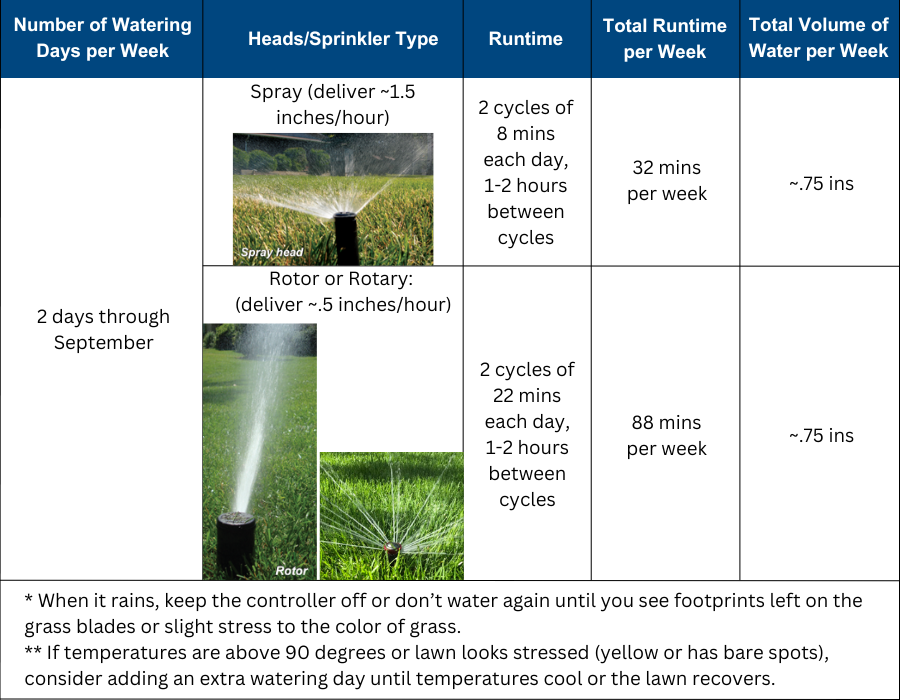Shift Your Water#

This summer has been hot and dry, and our landscapes have felt it! We want to help you save water AND keep your landscapes healthy this fall and winter.
Step 1: Prepare Your Landscape for Dormancy
- Save your fall cleanup for spring. Leave spent plant material like flower stalks and dried ornamental grasses to provide food for birds and shelter for insects
- Aerate to improve lawn health and reduce maintenance by helping air and water reach the root system
- Mulch fallen leaves into the lawn for beneficial nutrients
- Hand water weak areas of grass with a hose
- Spot seed if grass areas are depleted
- Apply fall fertilizer while irrigation is still active and water into grass
- Reduce sprinkler runtimes by 20% through September. See table below for suggested runtimes for end of season watering.

Step 2: Winterize in Early October
- Shut off your sprinklers in early October. By shutting down irrigation to healthy lawns early in the fall, we can see a big decline in community water use.
- winterize your system before the first freeze, which usually happens in early to mid-October.
- Disconnect and store hoses inside for the winter to prevent damage.
Step 3: Water Through the Fall and Winter
- Water trees, shrubs, lawns, and perennials during prolonged dry fall and winter periods to prevent root damage that affects the health of the entire plant.
- Water only when air and soil temperatures are above 40 degrees F with no snow cover.
- Apply water at mid-day so it will have time to soak in before possible freezing at night. A solid layer (persisting for more than a month) of ice on lawns can cause suffocation or result in matting of the grass.
- Find out more about winter watering
Tree Watering Guidelines#
Watering Newly Planted Trees:
- Mid-April to mid-October: 40 gallons per week
- Mid-October through November: 40 gallons every two weeks
- December to Mid-April: 40 gallons per month
Watering Established Trees:
- Water established trees twice a month during dry spells in fall, winter and spring.
- 10 gallons of water for every inch of diameter of tree trunk, every 10 days during the summer
An interview with City of Fort Collins Parks#
1. Why doesn’t Parks shut off their irrigation by Oct. 1?
Many of our parks are winterized in early to mid-October depending on the fall precipitation forecast. The decision to stop irrigating for the season is based on the needs and demands of the turf. Scheduled athletic activities for our sports fields are through the first weekend in November. Irrigating throughout the athletic season helps keep the play surfaces healthy, safe, and resilient. When we don't irrigate, the turf becomes damaged, resulting in more injuries and a less positive recreation experience. Most of our parks are completely winterized by mid-November, with an exception made for tree watering.
2. Why is it important for Parks to manage its water use and how do you do it?
Parks is looked to as a leader in water conservation and management techniques! We need to keep our parks aesthetically appealing, healthy, and safe for our community. During the growing season, Park Technicians monitor the amount of water used on park sites monthly and compare the total water used with the water the turf actually needs. This data helps us identify problems in our watering system and improves our water efficiency.
3. What are some notable projects that highlight Parks smart watering practices?
We have changed most of the watering controllers in our system to Weather Trak smart controllers. As an example, at Fossil Creek Community Park, we achieved a more than 20% reduction in the total gallons being used on a nightly basis for regularly scheduled irrigation after installing these smart controllers in 2022. This change also reduced the amount of energy being used to run our water pumps, saving electricity, and preventing wear and tear on expensive equipment.
We introduced hydro-zoning, which is now a part of our irrigation standards. Hydro-zoning is the practice of grouping plants together by their watering needs, which helps conserve water. This practice is being used at Crescent, Traverse and Sugar Beet parks and in all future park builds.
4. What technology helps you manage water use in Fort Collins parks and how does it work?
Our new Weather Trak equipment allows us to better manage our irrigation and alerts us to possible issues. For example, an irrigation system may have a leak and Weather Trak notifies us that excess water is being used and shows us where to look for the leak. This saves Parks time and money in diagnosing a problem that may have gone unnoticed for days with our previous technology. We also use rain and freeze sensors, high-efficiency irrigation nozzles and pressure regulators to make sure we water the landscape efficiently.
Additionally, 80% of our 1000 acres are irrigated with raw water. This non-potable water has not been treated by our Water Utilities department and is less expensive to the community. Most of our potable taps are associated with the over 100 streetscapes we steward, with most of these environments using drip irrigation to reduce evaporation.
Frequently Asked Questions#
-
This year we are shifting away from the prize drawing to teach our customers how to adjust their irrigation practices and shut off date to meet the lawn’s needs based on weather conditions. Since this year has been so hot and dry, some lawns have suffered and could use few extra days of irrigation this fall to ensure they come back healthy next year. Follow the tips above to save water and keep your lawn healthy.
Did You Know?
Off-peak Time-of-Day prices are approximately 70% less than on-peak prices.
You can save approximately 50¢ per load by drying your laundry during off-peak hours.
Fort Collins Utilities is committed to quality. See our annual Water Quality Report.